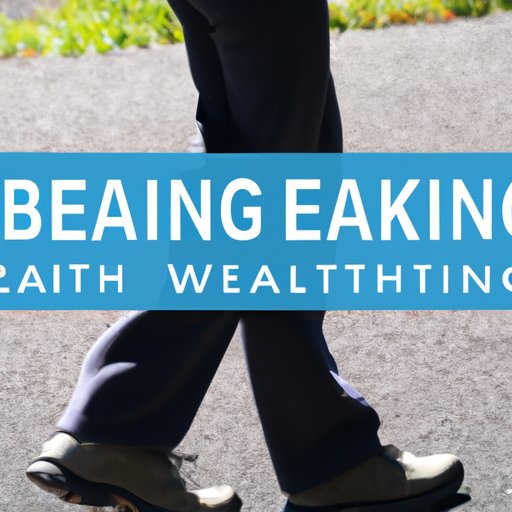Introduction
Walking is one of the most basic forms of physical activity, yet it is also one of the most beneficial. It is easy to do, requires no equipment, and can be done almost anywhere. But is walking really a good form of exercise? In this article, we will explore the science behind why walking is good exercise, the different types of walking exercises, and how to create a walking routine for maximum results.

Analyzing the Benefits of Walking as Exercise
The health benefits of walking are numerous. Here are some of the most significant:
Increased Cardiovascular Health
Walking is an aerobic exercise, meaning it increases your heart rate and improves the functioning of your heart and lungs. According to a study published in the American Journal of Preventive Medicine, regular walking can reduce the risk of coronary heart disease by up to 19%.
Improved Strength and Balance
Walking strengthens the muscles in your legs and core, helping to improve balance and coordination. This can help reduce the risk of falls, especially among older adults. A study published in the Journal of Gerontology found that regular walking can reduce the risk of falls by up to 24%.
Weight Management
Regular walking can help you maintain a healthy weight. According to a study published in the American Journal of Clinical Nutrition, walking for 30 minutes a day can lead to a modest reduction in body fat over time.
Improved Mood and Mental Clarity
Walking can also have a positive effect on your mental health. Studies have found that regular walking can reduce stress, improve mood, and even increase creativity. A study published in the Journal of Positive Psychology found that walking can lead to increased feelings of happiness, energy, and contentment.
The Science Behind Why Walking is a Good Form of Exercise
There are several physiological and psychological reasons why walking is a good form of exercise. Here are some of the key points:
Physiological Effects on the Body
When you walk, your body releases endorphins, which are hormones that make you feel good. These endorphins can help reduce stress and boost your mood. Additionally, walking increases blood flow to the brain, which can improve focus and concentration.
Benefits to Bone Density
Walking can also help improve bone density. As you walk, your bones are exposed to small amounts of pressure, which helps to strengthen them. Regular walking can help reduce the risk of osteoporosis, particularly in postmenopausal women.
Low Impact on Joints
Walking is considered a low-impact exercise, meaning it puts less strain on your joints than running or other high-impact exercises. This makes it an ideal form of exercise for people with joint pain or injury.
Exploring the Different Types of Walking Exercises
There are several different types of walking exercises that can help you get more out of your walking routine. Here are some of the most popular:
Speed Walking
Speed walking is a form of walking where you try to walk as quickly as possible. This type of walking can help you build endurance and burn more calories. To speed walk, maintain a brisk pace and keep your arms swinging back and forth.
Hill Walking
Hill walking is a great way to take your walking routine to the next level. By walking uphill, you’ll increase the intensity of your workout and challenge your muscles in new ways. It’s best to start slowly and gradually increase the incline as you become more comfortable.
Power Walking
Power walking is a type of walking that combines speed walking with interval training. You’ll alternate between periods of fast walking and slower walking, which can help you burn more calories and build muscle. This type of walking is great for those who want to take their walking routine to a new level.

Creating a Walking Exercise Routine for Maximum Results
If you want to get the most out of your walking routine, it’s important to create a plan that works for you. Here are some tips:
Setting Goals
Start by setting realistic goals for yourself. Decide how often you want to walk, how long each session should be, and what type of walking you want to do. Writing down your goals can help keep you motivated and on track.
Choosing the Right Shoes
It’s also important to choose the right shoes for your walking routine. Make sure the shoes you choose fit properly and provide enough support and cushioning to protect your feet and ankles. Consider investing in a pair of walking shoes specifically designed for the type of walking you’re doing.
Tracking Your Progress
Finally, it’s important to track your progress. Keeping a record of how far and how fast you’ve walked can help you stay motivated and see how far you’ve come. You can use a fitness tracker, smartphone app, or even a pencil and paper to track your progress.

Examining the Health Benefits of Regular Walking
In addition to the immediate physical and mental benefits of walking, regular walking can have long-term health benefits as well. Here are some of the key points:
Lower Risk of Heart Disease and Stroke
Studies have found that regular walking can reduce the risk of heart disease and stroke. A study published in the British Medical Journal found that walking for just 30 minutes a day can reduce the risk of heart disease by up to 35%.
Reduced Risk of Diabetes
Walking can also help reduce the risk of type 2 diabetes. A study published in the Diabetologia journal found that regular walking can reduce the risk of developing diabetes by up to 16%.
Improved Immune System Function
Finally, regular walking can help improve your immune system function. A study published in the Journal of Sports Medicine and Physical Fitness found that walking can help boost the body’s natural defenses against illness and infection.
Conclusion
Walking is a simple and effective form of exercise that can be done almost anywhere. It has numerous physical and mental health benefits, including improved cardiovascular health, increased strength and balance, weight management, improved mood and mental clarity, and improved immune system function. Whether you’re looking to lose weight, improve your health, or simply get some fresh air, walking is a great way to get active and stay fit.
(Note: Is this article not meeting your expectations? Do you have knowledge or insights to share? Unlock new opportunities and expand your reach by joining our authors team. Click Registration to join us and share your expertise with our readers.)
